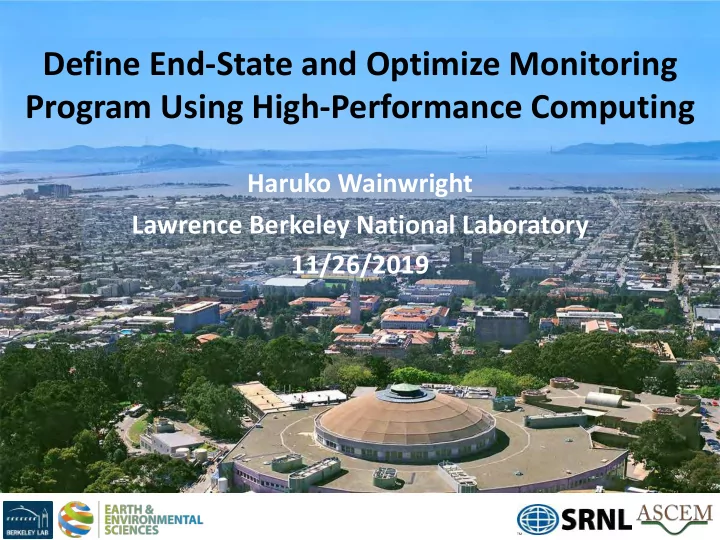

Define End-State and Optimize Monitoring Program Using High-Performance Computing Haruko Wainwright Lawrence Berkeley National Laboratory 11/26/2019
DOE-EM Sites: Progress Approximately $6B /year 107 major sites (1995) • 16 sites (2016)
Challenges Remaining sites…. • Complex contamination – Multiple radionuclides, heavy metals (Hg) – VOC and other organic compounds • Hard/expensive to access – Deep vadose zones – Increased drilling cost • Large volume with low contamination – Not practical to remove soil (too much $$/waste) – Treatment/removal technologies are not effective
Environmental Monitoring • Ensure public safety Beneficial for both residents • Prepare for liability issues and site operators Good example: Monitoring data proves Bad example: Data anomaly cannot be that the site is safe to dismiss false claims explained • extra >$100M
Research Goals • Transition from active to passive remediation and monitored natural attenuation – SRS F-Area (2004) $12M/yr • $1M/yr • Improve long-term monitoring – Great portion of life cycle cost (>$10M/yr) – Detect new leaks/migration • Ensure long-term stability of plumes – Climate change? 5
New Paradigm of Long-Term Monitoring • In situ sensors, wireless network, cloud computing • Autonomous continuous monitoring • Detect changes • Reduce monitoring cost Cloud Storage Computing phone tower data logger & modem work Artificial Neural Network Sensors computer Contaminant - Water Table concentrations - pH - Redox - Electrical Conductivity (EC) well Big Data
Data Analytics for Monitoring • Big Data analytics • Kalman filtering – e.g., Principle component – In situ real-time estimation of analysis (PCA) contaminant concentration – System understanding Tritium Concentrations – Master variables vs contaminant conc. Uranium Concentrations Schmidt et al. (2018, EST)
Big Interest in Environmental Monitoring 8
Modeling for Supporting Monitoring • Confirm the correlations: Master variables vs contaminant concentrations • Climate resiliency: how to place monitoring wells or what to expect in the response to climate changes • (In development) Monitoring well placement based on simulated plume evolutions
Demonstration: SRS F-Area • Disposal activities : – Disposal of low-level radioactive, acid waste solutions (1955– 1989) – Acidic plume with radionuclides (pH 3–3.5, U, 90 Sr, 129 I, 99 Tc, 3 H) • Remediation approaches – Pump & treat ($12M/yr) • Passive remediation (funnel-gate system for pH neutralization; $1M/yr) – Natural attenuation: long-term remediation alternative
Virtual Test Bed: ASCEM Overview Advanced Simulation Capability for Environmental Management 11
Geochemistry Development Surface complexiation, cation exchange • Complex geochemistry – pH Dependent – Aqueous complexation – Surface complexation Mineral dissolution/precipitation – Mineral dissolution/precipitation – Cation exchange – Decay Aqueous complexiation (and more) 12
Flow/Transport Model Bea et al. (2013) 13
3D Mesh Development 14
Uranium Plume Evolution Uranium Plume: Residual contaminants - Under the basins - Within Tan Clay ASCEM Modeling Results 15
Validation with Observations Uranium Al 3+ NO 3 - Good agreement with observations 16
In situ Monitoring: Master Variables vs U Conc. Nitrate (EC) pH Simulated Measured 17
Resiliency to Climate Disturbances Extreme Events • Flooding • Drought Savannah River Flooding, 2016 What will happen to residual contaminants? Technical Initiative in SURF and ITRC - How to prepare for climate change in sustainable remediation 18
Resiliency to Climate Disturbances 19
Flooding, Drought Impact Libera et al., submitted to EST +/- Precipitation/Temperature • Infiltration, ET Trade off: Mobility vs Dilution 20
Climate Scenarios: Flooding Basin Discharge Capping Basin: Residual Plume 1956 1989 2020 x2-10 21
Flooding Event Effect Export to the river Source-zone well (risk pathway) concentration - Increase in precipitation of ONE year: x1.5 – x 10 in 2020 Downgradient well - Dilution then Increase - Effect can linger for two decades - Source zone wells important to detect remobilization - Export to the river doesn’t change significantly 22
Monitoring Optimization • How can we identify key monitoring locations, using increasingly available spatially extensive data? – Geophysical plume mapping – Simulated plume evolution – Airborne gamma mapping
Fukushima Radiation Mapping • Integrate various types/footprints of data • Uncertainty quantification • Adopted by Nuclear Regulatory Agency Before Integration After Integration Wainwright H.M et al., (2016), A Multiscale Bayesian Data Integration Approach for Mapping Air Dose Rates around the Fukushima Daiichi NPP, J. of Env. Radioactivity 24
Monitoring Post Optimizations Interpolation Error Reduction log10(microSv/hr) Enough # of monitoring locations • Identified 100 locations that capture the variability of air dose rates Blue: Current locations • Extending to simulated Red: Optimized locations plume at the F-Area 25
Summary • Cost effective strategies for long-term monitoring – In situ sensors for continuous monitoring – Reduce cost while enhancing the safety – Data analytics : Kalman filter etc • Modeling for supporting monitoring – Confirming in situ monitoring strategies • Correlations between master variables and contaminant concentrations: Now and future – Climate change: what to expect, where to monitor? – Optimizing monitoring locations based on spatially extensive data (mapping data or simulated data)
Recommend
More recommend